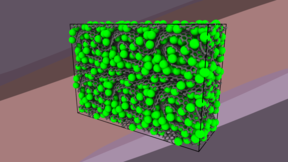A paradigm shift: machine learning is transforming research at the atomic scale

Assistant Professor Miguel Caro’s research group studies materials using atomistic simulations. By modelling how atoms interact, they can predict a material’s structure and properties. These computational methods accelerate the discovery of new materials and processes that support renewable industries and a sustainable economy.
The group applies these approaches to energy storage and conversion, catalysis, and advanced coatings and (opto)electronic materials. Biological applications are not a main focus, but the group engages in select collaborations, such as a project with Orion on solvation-energy prediction. Similar methods are widely used in biochemistry and pharmaceutical research by other groups.
The adoption of new machine learning methods is what makes this work possible.
‘Research like this was absolutely unthinkable 10 years ago. It’s not only that it was undoable; it’s also that we were not even imagining that the things we’re now doing with machine learning would be possible,’ Caro says.
Materials modelling has embraced machine learning faster and more deeply than many other fields. For Caro, whose main research focus has been machine learning for the past eight years, this rapid uptake shows that the gap between discovery and widespread use has never been smaller.
‘Looking back at my PhD, I would redo all of it with the new tools. I would do everything differently now, because I have these tools that would be much better for the job.’
Miguel CaroIt’s not just that this research was not possible a decade ago; we couldn’t even imagine the things we’re now doing with machine learning.
Exploring new materials with simulations
Caro’s group uses simulations both to interpret experimental results and to explore new ideas before committing to expensive or difficult laboratory work. Simulations are cheaper and faster than experiments and allow researchers to screen which directions are worth pursuing.
The team can explore unusual materials that would be nearly impossible to study experimentally.
‘Imagine that you were interested in studying the use of plutonium in a particular application. Because plutonium is radioactive, you would need an entire building to study it and follow tight safety measures, likely arguing with the Ministry of Defense whether you are even allowed to use it. But with the simulation, we can simply replace, say, iron atoms with plutonium and imitate the same kind of experiment,’ Caro says.
While the plutonium example is an exaggeration, the same principles apply to less exotic (but also less explored) chemistries. For instance, the group has also investigated alternatives to lithium – a scarce, expensive element used in batteries and largely controlled by China. For large-scale energy applications, like cheap batteries used to store intermittent power generated by solar panels, other materials may be viable.
The project examined whether sodium, magnesium, or potassium could replace lithium, and how these elements interact with different battery components. For sodium, the group has done this both experimentally with collaborators* and in simulation.
Miguel CaroWith these fast computational results, we can propose experiments that already have evidence behind them.
Bridging simulations and real-life experiments
Historically, there has been a divide between researchers doing simulations and those conducting experiments. According to Caro, that gap has narrowed as simulations have become more reliable.
Caro’s group uses its own machine-learning models and software trained on data they generate. Unlike generative AI tools such as ChatGPT, their approach relies on quantitative algorithms that have real predictive power.
‘ChatGPT is essentially a glorified autocomplete,’ he explains. ‘It can be very useful to get started on a topic but one must always check a trustworthy original source before believing it. What we use are quantitative ways of predicting quantities based on surrogate modeling – things like kernel ridge regression or neural networks trained from quantum mechanical simulation data or experimental results. They are not just making things up but rather enabling accelerated research.’
Machine learning is transforming materials science, but the speed of change can feel daunting. New tools and methods emerge faster than the researchers can adapt.
‘You work on a problem and before you can publish it, somebody has developed a much better way of studying the same problem. Machine learning is also about becoming more ignorant every day because the field is widening much faster than we can expand our own knowledge. There’s this metaphorical feeling of an expanse opening up underneath your feet.’
Miguel Caro began his four-year fixed-term as Assistant Professor at the Department of Chemistry and Materials Science in July 2025.
* The experimental collaboration on sodium-ion batteries has involved professor Tomi Laurila and his group, including PhD student Luong Trung, as well as the VTT Technical Research Centre of Finland. The main person from Caro’s group working on this project is postdoctoral researcher Alexis Front, with contributions from postdoctoral researcher Tigany Zarrouk. Funding was provided by RCF and the EU through the M-ERA.net program.
Data-driven Atomistic Simulation (DAS)
Research group led by Miguel Caro

Read more news

Research Council of Finland establishes a Center of Excellence in Quantum Materials
The Centre, called QMAT, creates new materials to power the quantum technology of coming decades.
Major funding powers development of next-generation machine technology aimed at productivity leap in export sectors
The BEST research project is developing new types of sealing, bearing, and damping technology.
The TAIMI project builds an equal working life – a six-year consortium project seeks solutions to recruitment and skill challenges
Artificial intelligence (AI) is changing skill requirements, the population is aging, and the labor shortage is deepening. Meanwhile, the potential of international experts often remains unused in Finland. These challenges in working life are addressed by the six-year TAIMI project funded by the Strategic Research Council, and implemented by a broad consortium.






